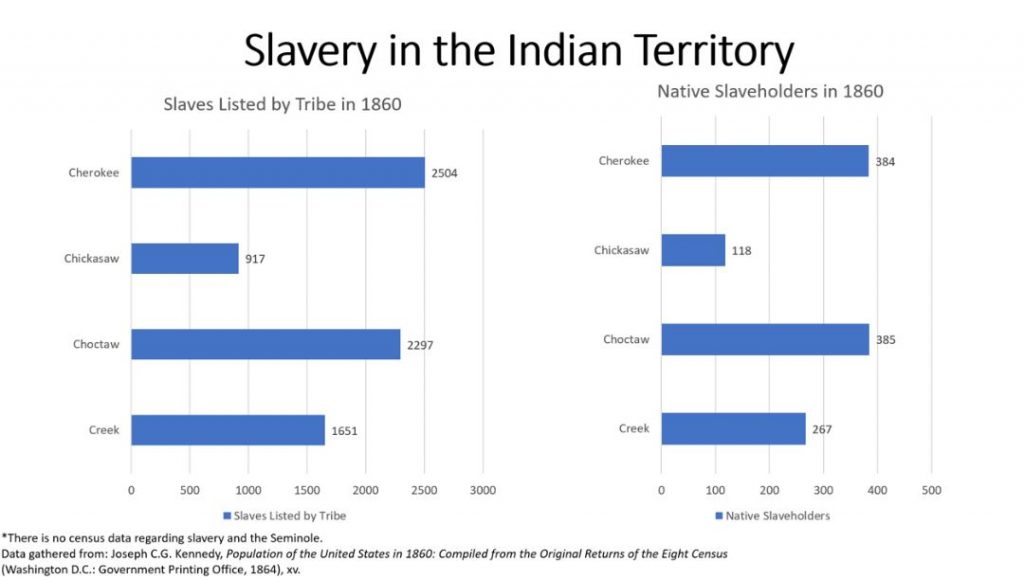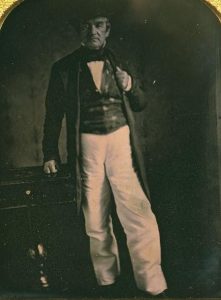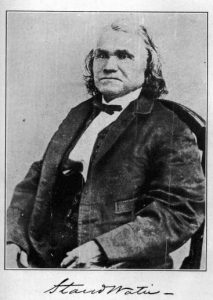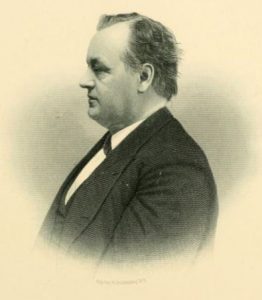Beyond the 13th Amendment: Ending Slavery in the Indian Territory
Emerging Civil War welcomes back guest author Neil P. Chatelain
When exactly did legal slavery end in the United States? Many Americans unfamiliar with the particulars of the Civil War respond with 1863 and the issuing of Lincoln’s Emancipation Proclamation. Still others respond with the 13th Amendment to the Constitution in 1865, a statement that is largely true. The systematic targeting of the peculiar institution continued throughout the conflict, culminating in its death throes by the end of the fighting and its formal abolishment during the Johnson Administration. Slavery however, continued as a protected institution in the Indian Territory, despite the 13th Amendment. Recognizing such, the Department of the Interior took steps that culminated in the signing of treaties with numerous Native American tribes, in order to both introduce reconstruction across the Indian Territory and move beyond the 13th Amendment and finally end slavery in all parts of the United States.

Author’s Creation
During the secession crisis following Abraham Lincoln’s election, great speculation resounded concerning the intentions of the Native American tribes located on reservations within the Indian Territory. The so called “Five Civilized Tribes” – the Cherokee, Chickasaw, Choctaw, Creek, and Seminole – each sought to adopt American customs in an effort to stave off their eventual relocation from their ancestral homelands to the Indian Territory. Among the efforts included the formation of a written alphabet by the Cherokee, the adoption of tribal constitutions among numerous tribes, and the adoption of the institution of slavery. Though relocation eventually occurred despite these efforts, the changes they espoused, including the adoption of slavery, remained firmly in place. By 1860, the populations of these five tribes included no less than 7,000 documented slaves, with numerous unrecorded cases raising some estimates to as high as 10,000, spread out between over 1,000 tribal slaveholders.

US Library of Congress LC-USZC4-11120
Wishing to gain favor with the different tribes, in the spring of 1861 the fledgling Confederacy dispatched Albert Pike as an emissary to the Indian Territory. Debate raged, but one by one, the “Five Civilized Tribes” each signed a treaty of alliance with the new Confederate government, doing so in a fractured manner with elements of each tribe’s population instead choosing to depart the territory as Unionist refugees.[1]
The Cherokee emerged as the most fragmented of tribes. Principal Chief John Ross, the recognized leader of the Cherokee, grew increasingly apprehensive about allying with the Confederacy. After learning that members of his tribe had already enlisted in Southern armies, Ross grudgingly acquiesced, forging an alliance via treaty in October 1861. Just a few months later, and based on his original concerns, Ross fled the territory and proceeded to Washington, where he met with President Lincoln and proclaimed both his loyalty as well as that of the Cherokee people. Lincoln was skeptical of Ross, but allowed him to remain in Washington, where he spent the remainder of the war attempting to garner support for his faction of the tribe.

Chronicles of Oklahoma, vol. 10, no. 4, p. 540
The war waged across the territory just as it did across the continent and thousands of Native Americans enlisted on both sides, the majority under the Confederate flag. Union forays in 1862 and 1863 took control over most of the territory, but campaigns further east forced most troops to relocate east and activity in the territory devolved into a series of small guerrilla conflicts in the latter half of the war. At the close of hostilities, Brigadier General Stand Watie, the leader of the Southern wing of the Cherokee, became the last general to give up the fight.
The Northern faction of the Cherokee took steps to end slavery in areas of their control. Just a few weeks after the Emancipation Proclamation went into effect, they signed their own proclamation of emancipation, declaring an end to slavery within the Cherokee Nation. Unsurprisingly, the majority of Cherokee, within Confederate lines and siding with the Southern faction, ignored the document. Northern Creeks similarly adopted Lincoln’s Emancipation Proclamation, but most tribal members, also within Confederate lines, likewise ignored the stance.[3]Throughout the war, slavery continued to remain a major issue within the Lincoln administration. The Confiscation Acts of 1861 and 1862 became the first steps taken against the institution by the government, providing the ability for soldiers to confiscate the property of people taking part in the rebellion – including property in the form of slaves. In 1862, the national government passed an act outlawing slavery in all United States territories, excepting federally designated protected Native American lands under tribal autonomy. The Emancipation Proclamation emerged as the major step forward in the battle to end slavery, but it too failed to take the Indian Territory into consideration, instead applying only to “any State, or designated part of a State” in rebellion.[2]

Genealogy of the Cleveland and Cleveland Families. Vol. II, Hartford, CT: Case, Lockwood, and Brainard, 1899, 1256
At the end of the war, the reconstruction process commenced and the Indian Territory was not exempt. Though Abraham Lincoln desired, and the Johnson Administration advocated for, a soft peace and quick reconstruction of the Union, a different stance was taken when it came to relations with native tribes that had sided with the Confederacy. In the opinion of the Johnson administration, all Native American tribes that made formal alliances with the Confederacy had their official treaties with the United States declared null and void; new treaties would have to be written and adopted to reestablish formal relations with the national government. To oversee the reconstruction of these tribes, the Department of the Interior organized a gathering at Fort Smith Arkansas, overseen by Dennis N. Cooley, the Commissioner of Indian Affairs. The Southern Treaty Commission convened in September 1865 and included representatives from over fifteen tribes, including members of each of the “Five Civilized Tribes.” Once again, the different tribal factions vied for power, unsurprisingly and most notably within the Cherokee. Former Confederate General Stand Watie and Principal Chief John Ross both claimed to represent their nation and squabbling continued throughout the process until the national government refused to officially recognize Ross, who soon after died while appealing the decision.
Numerous treaties were drawn up regarding each tribe assembled at the commission. Regarding the “Five Civilized Tribes,” four major treaties were negotiated and formally signed in 1866 – one with the Cherokee, one with the Creek, one with the Seminole, and a combined treaty with the Chickasaw and Choctaw. These treaties each contained four major provisions. To begin with, as punishment for aiding the Confederate rebellion, each tribe forfeited lands amounting to about half of their designated protected territory. The forfeited lands would be used for both the laying of railroads and for the concentration of numerous Plains tribes onto their own reservations within the Indian Territory, opening more of the West for settlement. The second provision of these treaties declared a general amnesty for all Native Americans who had violated previous treaties, broken laws, or joined in the Southern rebellion.
The final two provisions concerned ending slavery. Language identical to that in the 13th Amendment was written into each treaty, guaranteeing a final end to the institution of slavery. The final provision provided for the adoption of all freed slaves as immediate and recognized citizens within their respective tribes. Each of the “Five Civilized Tribes” voiced their concerns regarding these provisions, but ultimately, all approved their respective treaties. The nations each ratified final drafts in the spring and summer of 1866 and they went into effect in July and August of the same year, providing a final end to legal slavery within the Indian Territory, fully nine months after the 13th Amendment took effect across the rest of the United States.[4]
Treaty negotiation meant nothing to the slaves still in bondage across the Indian Territory, continuing as if the war had never occurred. R.C. Smith’s family had been enslaved for generations, with both his grandfather and father at one point being owned by John Ross himself. Seeking to keep his property from being confiscated, at the start of the war, Smith’s owner sent him to Texas, far away from Union lines. His father remained in the Indian Territory and eventually escaped to Union lines, joining a regiment in Kansas. Towards the end of the war, Smith was returned to his master in the Cherokee Nation’s territory. There he remained even after the 13th Amendment went into effect. “I was 17 or 18 years old when Abe Lincoln declared us free,” Smith later recalled, “but I never got my freedom till August 4, 1866,” fully eight days after the Cherokee Reconstruction Treaty was ratified and went into effect.[5]
These reconstruction treaties marked a profound impact in relations between the United States Government and Native Americans across the country. The reestablishment of relations with tribes allied with the Confederacy became an important first step, with the forfeiture of certain lands as a consequence needed to further the government’s agenda of concentration of Native Americans across the Plains onto reservations. Most importantly, a final end to slavery in North America became finally realized with the ratification of these documents, bringing a terminus to the outlines and desires of Abraham Lincoln, and ensuring freedmen received rights as citizens, presaging the 14th Amendment to the Constitution. This did not solve all issues however, as decades of squabbling continued between Native Americans and the freedmen members of their tribes, echoing the strife faced by freed slaves and their descendants across the rest of the country into the twentieth century and beyond.[6]
Neil P. Chatelain is an Instructor at Lone Star College-North Harris and a Social Studies Teacher at Carl Wunsche Senior High School in Spring, Texas. A former US Navy Surface Warfare Officer, he is a graduate of the University of New Orleans, the University of Houston, and the University of Louisiana-Monroe. Neil researches US Naval History, with a particular emphasis on naval operations of the Confederacy.
Sources:
[1] Joseph C.G. Kennedy, Population of the United States in 1860; Compiled from the Original Returns of the Eighth Census (Washington D.C.: Government Printing Office, 1864), 161.
[2] Abraham Lincoln, “Emancipation Proclamation,” Complete Works of Abraham Lincoln, ed. by John G. Nicolay and John Hay (Harrogate, TN: Lincoln Memorial University, 1894), xv.
[3] Indian Affairs: Laws and Treaties, vol. 2, ed. by Charles J. Kappler (Washington D.C.: Government Printing Office, 1904), 944.
[4] Each of the treaties with the “Five Civilized Tribes” can be found in Indian Affairs: Laws and Treaties, Vol. 2 (Washington D.C.: Government Printing Office, 1904), 910-916, 918-937, 942-950
[5] T. Lindsay Baker and Julie P. Baker, eds., The WPA Oklahoma Slave Narratives (Norman, OK: University of Oklahoma Press, 1996), 401.
[6] Claudio Saunt, “The paradox of Freedom: Tribal Sovereignty and Emancipation during the Reconstruction of Indian Territory,” Journal of Southern History, vol. 70, no. 1 (January 2004), 75-76.
“The adoption of slavery…” Which Indian tribe did not have slaves of every color? Consider the Pawnee who were valued as slaves.
This is a fascinating account. Thank you for writing it.
Thank you for this. I’m from Oklahoma and had no idea until recently that the citizens of Greenwood descended from this slave population. I’m trying to learn more, and this was a huge help!
Was just looking up population numbers for the Indian Territory in 1860 and noted the 7k enslaved people counted. Great subject to write about!